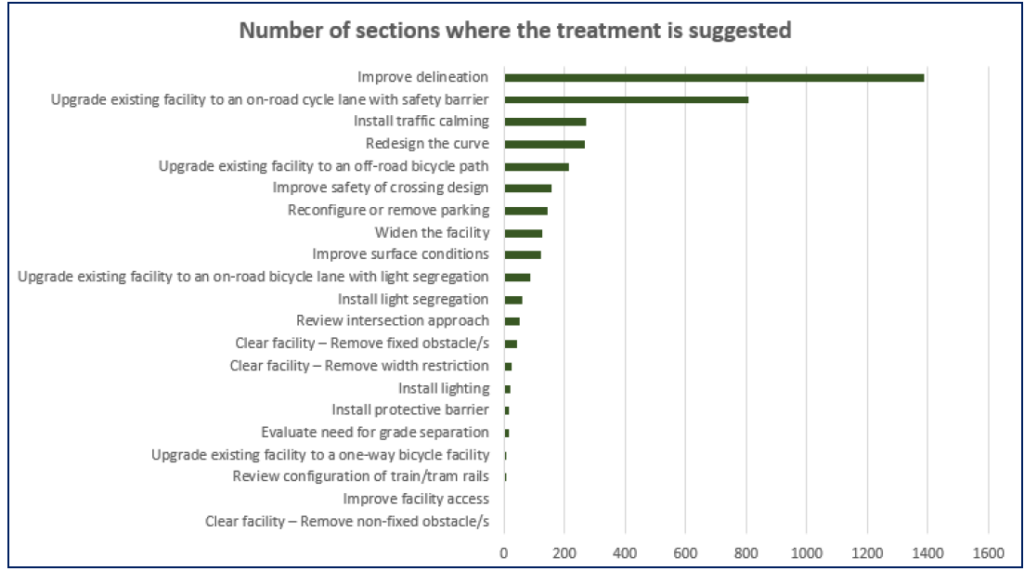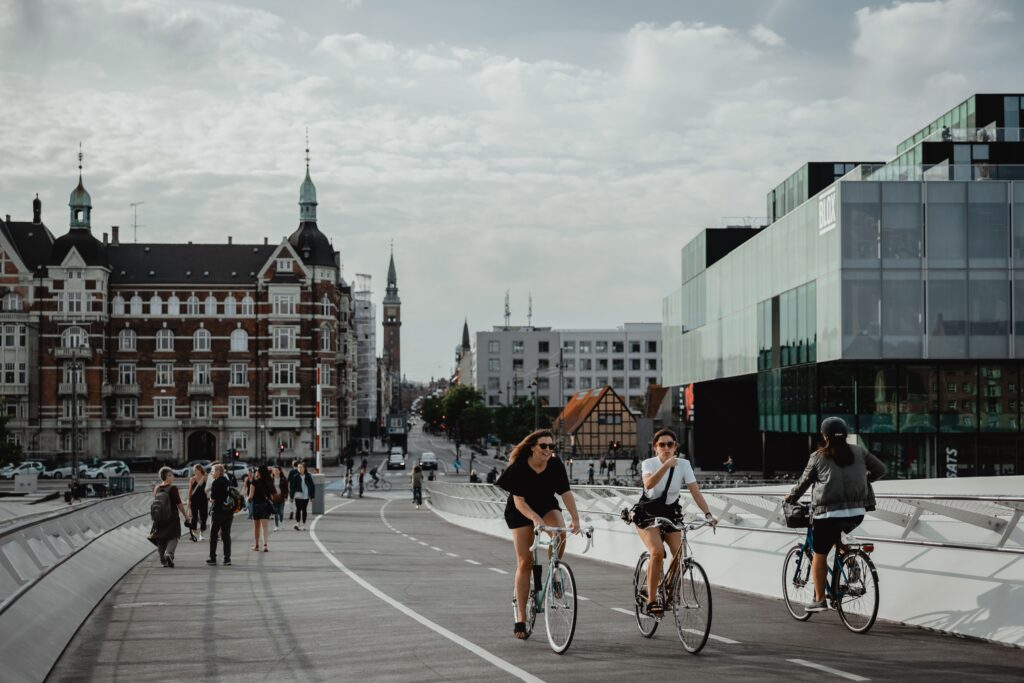Road safety and active mobility share a genuine and true love affair, forming a perfect combination. On the one hand, road safety ensures a sense of comfort for vulnerable road users such as pedestrians, cyclists, and e-scooter users. On the other end, there is a direct correlation between the space dedicated to active mobility in our streets and a reduction of accidents at an urban level.
What is road safety?
Road safety refers to measures and precautions taken to prevent accidents, injuries, and fatalities on roadways. It encompasses various strategies, policies, and practices designed to reduce the risk of accidents and promote safe behaviour among road users.
Road safety aims to create an environment where people can travel with minimal risk of accidents, injuries, and fatalities.
What is active mobility?
Active mobility refers to modes of transportation that involve physical activity, typically through walking, cycling, or other human-powered means. It promotes using one’s energy to move from one place to another, in contrast to passive modes of transport like motorised vehicles. Active mobility contributes to physical well-being and environmental sustainability and often supports a more livable and vibrant community.

Light segregation between cyclists and traffic in Barcelona city centre (Source: Barcelona City Council)
Road safety: always a trending topic
Do you know that as you read the first paragraph of this article, at least two people lost their lives in a road crash? Every 24 seconds, a road fatality occurs in our world, with 4% of them involving cyclists. It is also essential to highlight the devastating figures of serious injuries (approximately 20 million people per year from various modes of transport), which are equally important in achieving the Vision Zero objective – zero fatalities and zero injuries on our roads and streets.
Is Vision Zero an achievable milestone? It may seem complicated when considering the figures mentioned above. Nonetheless, moving “as close as possible to zero fatalities in road transport” is one of the long-term goals endorsed by the European Commission by 2050.
In addition, Vision Zero has already been implemented at the urban level, with several important cities successfully eliminating traffic fatalities from their streets.
Urban Safety Done Right: Oslo
Oslo, a city with 635,000 residents, stands out, having achieved a “clean sheet” in recent years regarding killed pedestrians, cyclists, and children.
This starkly contrasts with 1975, when the Norwegian capital city suffered 41 traffic deaths. How can these numbers be explained? The most probable aspects that had a higher impact on improving traffic safety in Oslo are the extension of the cycling network, reduced traffic in residential areas, and the innovative concept of “heart zones” near schools, allowing parents to drop off and pick up their children in a safer way. In general, Oslo has replaced on-street parking spots with lengthened cycle lanes, representing a modal split from cars to bicycles.

Before / After the replacement of parking spots in Huitfeldts Gate, Oslo
(Source: Agency for Urban Environment, City of Oslo and The Guardian)*
Extending the Cycling Network to promote Active Mobility
A redistribution of the urban space to promote active mobility and an extension of the cycling network is not unique to Scandinavia. Several cities have embraced this reallocation of urban areas. For example, Paris would play a hypothetical Champions League of best practices in urban road safety. The French capital is moving from a car-centric paradise to a 100% cyclable city concept, according to the Plan Vélo 2021-2026. The cycling infrastructure now spans over 1,120km (compared to less than 200km in 2001).
The city has also implemented a Gender and Public Space plan to create safer and more accessible urban areas. At the same time, cars have been banned on certain roads along the Seine River through the city centre, and the French energy-efficiency programmes are providing an extra budget for the development of cycling infrastructure, according to the European Cyclists’ Federation. It’s a strategic move and a nice cover letter for hosting the Olympic Games in 2024.
The importance of safe cycling infrastructure
The extension of cycling networks and the quality of infrastructure are popular concerns in the mobility field, confirmed by the European Cycling Declaration adopted by the European Commission in October 2023. Vulnerable road users such as pedestrians, cyclists and motorcyclists remain dangerously exposed. According to the 2023 Global Status Report on Road Safety developed by the WHO, only 0.2% of all infrastructures assessed have dedicated cycle lanes.
To address these challenges, new tools like Lane Patrol are gaining momentum. Lane Patrol provides insights for safer and more comfortable cycling infrastructure as this system implements the evidence-based and preventive CycleRAP methodology to assess and improve cycle lanes in our cities.
Madrid’s Evolution to a Bike-Friendly City
One of the cities that have deployed the Lane Patrol assessment is Madrid. Although not traditionally recognised as bike-friendly, Madrid is rapidly climbing the ranks of cyclist-friendly cities, typically dominated by Amsterdam and Copenhagen.
Why? The Madrid 360 Sustainable Urban Mobility Plan” is part of the reason. It aims to establish a basic cycling network of 570km by 2025. The plan also includes complementary measures, such as converting roads with more than one lane per direction into multi-modal lanes. As part of the action plan, a risk map has been developed, and the city council has applied the CycleRAP methodology to assess 98km of their cycling infrastructure, covering various types of sections: segregated bike lanes, shared “ciclo-carriles”, etc.

Road safety measures suggested in Madrid cycling network (Source: Safer Cycling Around the World – IRAP)
Insights from Madrid’s Cycling Network Assessment by Lane Patrol
As expected, the results have shown that interaction with traffic is the major risk by far (50%), followed by conflicts with pedestrians (26%), and crashes with other bikes (24%). The Lane Patrol tool listed several countermeasures to alleviate the challenges of the current cycling network in Madrid. Among the suggestions, we can point out adding light segregation in specific segments, upgrading existing facilities to an on-road bicycle lane, improving crossing design, or providing a cycling-priority street.
Finally, the road safety assessment tool also suggested some “quick wins” and cost-effective solutions. For example, improving delineation, installing traffic calming, and removing parking spaces. The road safety treatment proposal offers qualitative insights to policymakers and provides quantitative information on the risk mitigation for each measure.

Lane Patrol implementation in Madrid (Source: Lane Patrol platform)
The double-zero concept and its gender perspective
As highlighted at the beginning, road safety is a paramount concern that will always hold a prominent place at the mobility table. Saving lives is undeniably of utmost importance. But it is equally imperative to recognise the direct relationship between the provision of safer bike lanes and sustainable and inclusive mobility.
Incorporating the double-zero concept into road safety initiatives extends beyond the pursuit of zero crashes to encompass zero emissions. While the primary focus centres on saving lives, it is essential to acknowledge that the concept surpasses mere accident prevention.
Moreover, sustainable mobility is pivotal to achieving a modal shift towards active mobility. The comfort and safety of citizens walking or cycling play a crucial role in this shift. A safe cycling network enhances road safety and yields numerous benefits. These advantages go from decarbonising urban mobility, reducing air and noise pollution, and promoting the health advantages of an active lifestyle. This, in turn, can save a significant number of lives. The correlation between road safety, comfort, and the growth of active mobility forms the best recipe for cities to achieve long-term goals, including climate neutrality. Therefore, we strongly advocate for the double-zero concept—zero crashes and zero emissions—in our mobility landscape.
Inclusive mobility: What does it entail?
A safer cycling infrastructure is inherently inclusive because it provides everyone access to this active transport mode. Who are the first to leave the bike at home? The elderly, children, and women may avoid riding bikes or e-scooters due to discomfort and uneasy feelings. Women are more likely to use sustainable modes such as walking and public transport, but what about cycling?
The gender gap is significant in cities with low cycling rates and less developed cycling networks. However, the disparity disappears in bike-friendly cities from The Netherlands, Denmark, and Germany, in particular in the cities with dedicated cycling infrastructure. Several studies show that women are more likely to cycle than men when the bike lanes are well-lit and fully separated from traffic. This is actually one of the most important parameters of the CycleRAP methodology. In Copenhagen, 55% of bicycle trips are made by women, and in Paris and Lisbon, the gender gap is smaller due to recent investments in protected bike lanes.

A new bridge in Copenhagen for cyclists and pedestrians. It’s separated from the road, which increases safety. (Photo by Febiyan on Unsplash)
REALLOCATE Project: Pioneering Innovation for Safe and Sustainable Urban Mobility
The ongoing saga of the affectionate relationship between road safety and active mobility is set to unfold in the REALLOCATE project. Funded by the European Commission, this ambitious project is dedicated to forging a path toward climate-neutral and safe cities through innovative solutions. REALLOCATE is led by University College of Dublin with key stakeholders such as Eurocities, ERTICO and ICLEI. Factual is coordinating 15 pilots across 10 Missions cities, where the safety of vulnerable road users is one of the main concerns.
These pilots are intricately designed to incorporate a mix of new technologies, promoting modal shifts catering to the needs of diverse groups. Simultaneously, they aim to rebalance the public space allocation, ensuring a more inclusive and efficient urban environment. This flagship project enables researchers, mobility experts, urban planners and local citizens to collectively re-imagine our cities and redesign how we move from one place to another. If this is not a true love story…
Road safety and active mobility go hand in hand
The intersection of road safety and active mobility presents a compelling narrative of shared interests and mutual benefits. As we navigate the challenges posed by global road fatalities, the success stories of cities like Oslo underscore the potential for evidence-based urban planning to save lives.
Investing in high-quality cycling infrastructure emerges as a key recommendation. The focus is on dedicated, cycling-safe lanes to transform urban environments. As exemplified by Lane Patrol and CycleRAP, innovative tools and methodologies offer valuable insights and effective countermeasures to enhance road safety.
Madrid’s trajectory towards becoming a cyclist-friendly city highlights the transformative impact of comprehensive urban mobility plans, reinforcing the correlation between road safety, comfort, and sustainable growth. Recognising these interdependencies is pivotal for achieving long-term sustainability goals, including the ambitious Vision Zero objective.
Safer cycling infrastructure promotes inclusive mobility and addresses gender disparities, as portrayed by success stories in Copenhagen, Paris, and Lisbon. The REALLOCATE project, supported by the European Commission, symbolises a forward-looking initiative to redefine urban spaces, promoting modal shift, inclusivity, and sustainability.
These insights collectively advocate for global collaboration, innovation, and strategic urban planning to foster safer, sustainable, and inclusive cities for all road users.
Written by Marc Figuls and Eglantina Dani.





